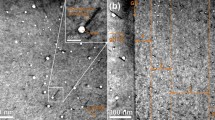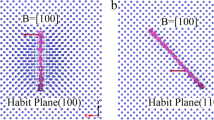Abstract
EXTENSIVE void formation occurs in metals subjected to fast neutron irradiation in the temperature range of 0.3 Tm to 0.5 Tm where Tm is the melting temperature of the metal1–4. This phenomenon is a serious problem in reactor technology. In conditions of fast neutron irradiation large numbers of lattice vacancies and interstitial atoms are produced in equal amounts. Dislocation lines and voids (pre-existing ones or newly nucleated ones) act as sinks to these point defects. If a void is just as efficient a sink for an interstitial atom as for a lattice vacancy and if a dislocation line also is just as efficient a sink for each of these types of defect there can be no tendency for a void to grow2–4. Equal numbers of vacancies and interstitials will be destroyed in a void as well as at dislocation lines. But dislocation lines are probably a more efficient sink for interstitials than for vacancies. Thus more interstitials are destroyed at dislocation lines than are vacancies. The excess vacancies are destroyed at voids, causing them to grow. This very plausible explanation has been presented in the literature to account for growth of voids (see refs. 2–4 and the references cited there).
This is a preview of subscription content, access via your institution
Access options
Subscribe to this journal
Receive 51 print issues and online access
$199.00 per year
only $3.90 per issue
Buy this article
- Purchase on Springer Link
- Instant access to full article PDF
Prices may be subject to local taxes which are calculated during checkout
Similar content being viewed by others
References
Cawthorne, C., and Fulton, E. J., Nature, 216, 576 (1967).
Harkness, S. D., and Li, C.-Y., Metallurgical Trans., 2, 1457 (1971).
Bullough, R., and Perrin, R. C., Radiation-induced Voids in Metals (edit. by Corbett, J. W., and lanniello., L. C., 769 (US Atomic Energy Commission, 1972).
Adda, Y., Radiation-induced Voids in Metals (edit. by Corbett, J. W., and lanniello, L. C.), 31 (US Atomic Energy Commission, 1972).
Ham, F. S., J. Appl. Phys., 30, 915 (1959).
Author information
Authors and Affiliations
Rights and permissions
About this article
Cite this article
GREEN, W., WEERTMAN, J. Dislocation Vibration as a Possible Cure for High Temperature Void Formation in Metals under Fast Neutron Irradiation. Nature 243, 159–160 (1973). https://doi.org/10.1038/243159a0
Received:
Issue Date:
DOI: https://doi.org/10.1038/243159a0
Comments
By submitting a comment you agree to abide by our Terms and Community Guidelines. If you find something abusive or that does not comply with our terms or guidelines please flag it as inappropriate.



